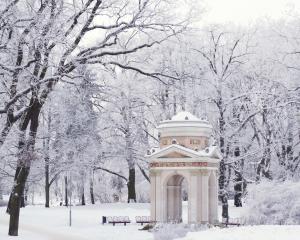Gillian Vine visits Lautoka, Fiji's ''Sugar City'' and finds a Dunedin connection.
''What would you like?'' asks the bartender as I relax on Fiji Princess after a laid-back day touring the Yasawa Islands.
Decisions, decisions.
I figure a pina colada is the answer. Fiji produces all the ingredients- coconuts, pineapples, limes and rum, so the drink could be considered a Fijian product, even though it's Puerto Rican in origin.
There is another reason for my choice, a Dunedin connection.
Produced at Lautoka's South Pacific Distillery using second-hand equipment that came from Wilson's Distillery in Dunedin, Bounty rum is an award-winning tipple developed by the Fiji Rum Company.
On his office wall in Lautoka, rum development manager Liam Costello has a photo of the container ship Capitaine Wallis, its decks packed with tanks and other equipment, leaving Dunedin in July 1980.
''The equipment purchased from the Wilson's Distillery is still in use and helping us to make world-class, award-winning rums,'' Mr Costello said.
South Pacific Distillery is based in Lautoka, which, with a population of some 52,000, is the country's second-largest city, after the capital, Suva (86,000). The company was established in 1979 to make spirits to replace imported ones and production began in 1980. As well as rum, it produces Regal London Dry Gin and Regal Whisky and Regal Deluxe Whisky.
The decision to make rum was logical, as the main ingredient, molasses, is a by-product of the sugar industry, pure water is available and Fiji's hot humid climate is ideal for maturing the spirit. Cutting cane by hand means richer juice with fewer tannins, another plus for rum-making.
Sugar, which now earns Fiji about $NZ150 million annually, is second to tourism as the country's main source of income.
When the first Europeans reached Fiji, sugar was already being grown by local people, who chewed the cane and used the juice to sweeten food. In 1862, David Whippy produced the first crystallised sugar on the island of Wakaya, now a privately owned resort. His efforts flopped but a decade later, a mill was built near the present-day city of Suva and about 250ha of cane planted nearby.
The site was not ideal, as sugar was found to grow better on the sunnier, drier eastern side of Fiji's two biggest islands, Viti Levu and Vanua Levu. By about 1870, land once used for cotton had been turned over to sugar cane and by 1883 the crop had displaced copra (dried coconut) as the country's main export.
These days, more sugar is being grown and the harvesting season, June to December, overlaps with the main tourist season so visitors are likely to see cane being taken to one of Lautoka's four sugar mills on flat-topped railway wagons.
Lautoka, Fiji's ''Sugar City'', lies at the centre of the cane-growing area. During the week it is a bustling town, but on Sundays the streets are deserted and the huge market closed and by mid-afternoon even the handful of vendors outside the gates are packing up their fruits and vegetables.
Apart from the churches, mainly Methodist or Catholic, the busiest place is the hospital, although the large sign, ''Lautoka Morgue Services'', at the entrance must be a disincentive for those seeking treatment. Fortunately, I'm not in need of medical attention and head back to Denarau.
Although small-vessel cruising is important, many visitors to Fiji stay put. Because they like the same hot, dry weather as sugar, the country's main tourist belt, from the Coral Coast to Lautoka, overlaps with the cane-growing area.
It works for the Fiji Rum Company, too, as handily located opposite the Sheraton Resort on Denarau is its main outlet. A sampling paddle to try four rums costs $F12 (about $NZ8) and prices per bottle are from about $NZ40.
If you want rum to take home, duty-free outlets at Nadi Airport have some Bounty products at lower prices. Even if you don't buy a bottle of spiced or honey rum, or the more conventional dark and white types, do indulge in a long, cool pina colada made with the spirit of Fiji.
• Gillian Vine took a four-day cruise on Fiji Princess as the guest of Blue Lagoon Cruises.
For schedules, fares and general information, see www.bluelagooncruises.com
Indian cane workers
A third of people living in Fiji are of Indian descent, whose ancestors were the indentured labourers brought from Calcutta and Madras between 1879 and 1916 (and later free migrants) to work in Fiji's sugar plantations. Known as girmityas, the indentured labourers lived in what have been described as squalid conditions and women were often molested.
Under the terms of indenture, girmityas were required to work for five years, after which they were free to return to India. Many stayed, probably because they could not afford the fare home, and settled in Lautoka or Nadi, near to the cane fields where they had worked.
Their heritage is seen not only in Fiji's Hindu temples, such as Nadi's Sri Sivasubramaniya Swami, but also in their involvement in business, with names like Singh on every other shop in Lautoka. Classy retailer Prouds is Indian-owned and operated, as is major tourism venture Selva Tours.
Those of Indian descent speak Hindi, modified by their long exile from their homeland, and generally support the Fiji Labour Party, led by former Prime Minister Mahendra Chaudhry, who lost his position in the May 2000 coup, led by George Speight. In mid-May, after being convicted of currency fraud, Mr Chaudhry was fined nearly $F2 million (about $NZ700,000). He is appealing the conviction.
Pina colada
Recipes vary for this tropical cocktail but the basic ingredients are always the same - rum, coconut cream and pineapple juice blended with crushed ice.
Typical proportions are 60ml white or golden rum, 45ml coconut cream and 45ml pineapple juice, 1 cup crushed ice. A dash of fresh lime is sometimes added and the drink garnished with a wedge of pineapple.












